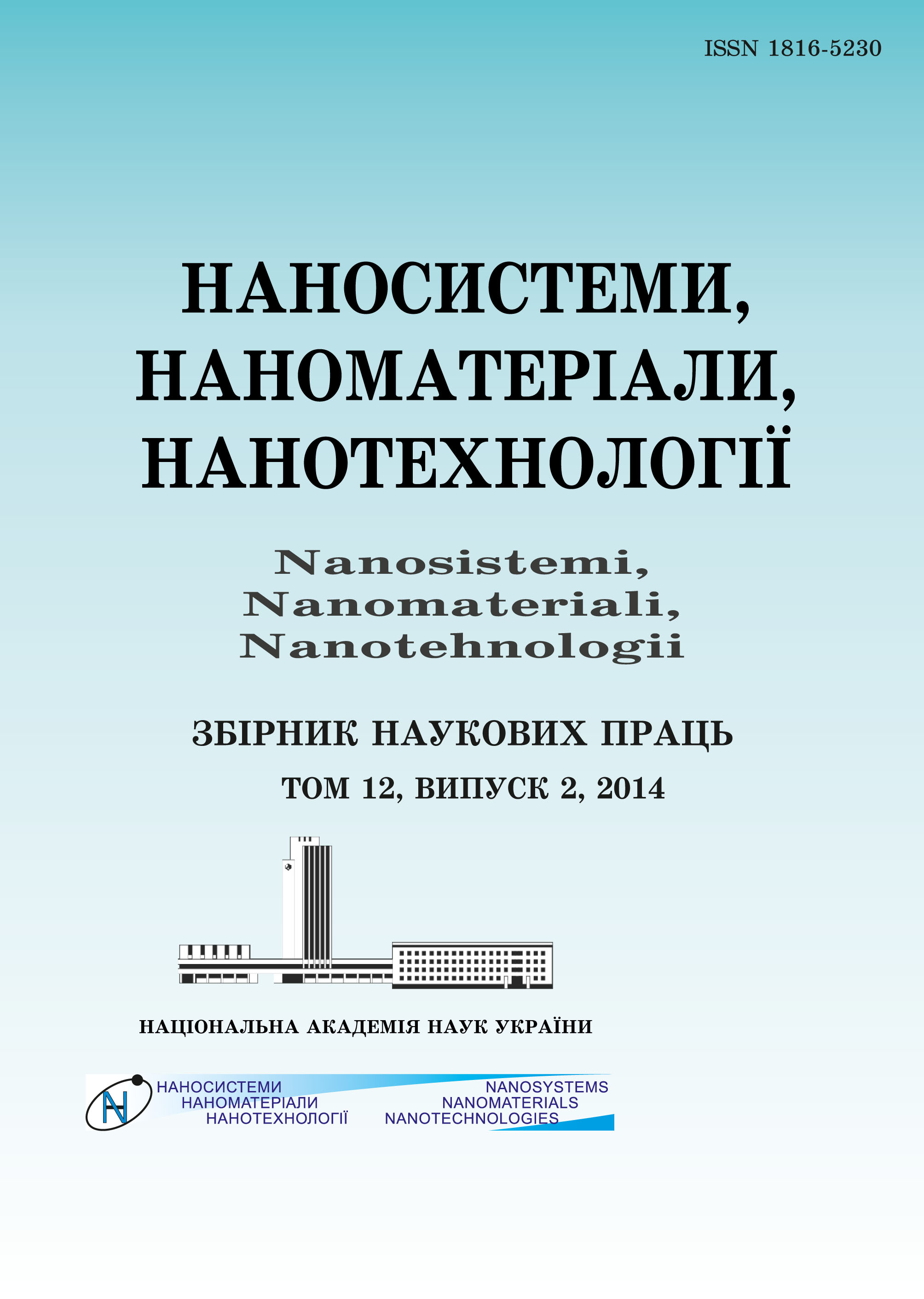|
|
|||||||||

|
Year 2024 Volume 22, Issue 1 |
|
|||||||
|
|||||||||
Issues/2024/vol. 22 /issue 1 |
|
M.A. ZABOLOTNYY, L.˛. ŔSLAMOVA, V.P. VASHCHYN, D.O. GRYNKO,
A.A. KOLESNICHENKO, D.S. LEONOV, D.O. KRASNOVYD, V.V. VOVK, M.M. PETRYSHYN,
R.V. LYTVYN, S.O. RUDENKYI, and Ě.YU. BARABASH
Features of Relationship Between Rheological and
Photogeneration Characteristics of PEPC+C60 Composites
93–106 (2024)
PACS numbers: 61.43.Er, 65.60.+a, 68.35.bm, 73.50.Pz, 78.40.Me, 82.35.Np, 83.60.-a
The process of photogeneration of charges and the temperature of the transition to the viscous-flow state (Tv) in thin films of polyepoxypropylcarbazole PEPC–C60 composites fabricated by means of toluene-solution casting in strong external electric fields are investigated. Consistent and correlated changes in the temperature of the transition of the sample material to viscous-flow state (Tv) and in the effective temperature of the quantum yield of photogeneration (T0) are found out. As shown, the difference between Tv and T0 for the PEPC–C60 composites does not exceed 10% of these values, when the concentration of C60 fullerene changes. This indicates changes in the molecular structure and, consequently, dielectric constant in the vicinity of the centre of photogeneration of electric-charge carriers
KEY WORDS: amorphous molecular semiconductor, fullerene, photogeneration, electric charge, current density
DOI: https://doi.org/10.15407/nnn.22.01.093
REFERENCES
- G. Dennler, N. S. Sariciftci, and C. J. Brabec, Conjugated Polymer-Based Organic Solar Cells, Semiconducting Polymers: Chemistry, Physics and Engineering (Eds. G. Hadziioannou and G. G. Hunray) (Weinheim: Wiley: 2006), vol. 1, p. 455–519.
- M. A. Zabolotnyi, L. I. Aslamova, E. M. Boboshko, A. A. Kolesnichenko, D. S. Leonov, R. V. Lytvyn, A. Yu. Sezonenko, M. M. Yamshinskij, and M. Yu. Barabash, Nanosistemi, Nanomateriali, Nanotehnologii, 21, Iss. 2: 261 (2023); https://doi.org/10.15407/nnn.21.02.261
- V. Anand, T. Tahara, and W. M. Lee, Advanced Optical Holographic Imaging Technologies. Appl. Phys. B, 128: 198 (2022); https://doi.org/10.1007/s00340-022-07921-9
- H. H. Vlaikov, M. Yu. Barabash, M. A. Zabolotnyi, D. O. Hrynko, Yu. M. Barabash, and L. Yu. Kunytska, Formuvannya Nanostruktur Templantnym Syntezom [Formation of Nanostructures by Template Synthesis] (Kyiv: G. V. Kurdumov Inst. For Metal Physics, N.A.S. of Ukraine: 2010) (in Ukraine).
- Piotr Grygiel, Karol Falkowski, Daniel Pelczarski, and Waldemar Stampor, Organic Electronics, 39: 328 (2016); https://doi.org/10.1016/j.orgel.2016.10.023
- G. Pfister and D. J. Williams, J. Chem. Phys., 61: 2416 (1974); https://doi.org/10.1063/1.1682344
- V. Gulbinas, Lithuanian Journal of Physics, 60, No. 1: 1 (2020); https://doi.org/10.3952/physics.v60i1.4160
- N. H. Kuvshynskyi, N. A. Davydenko, and B. M. Komko, Physics of Amorphous Molecular Semiconductors (Kyiv: Lybed’: 1994) (in Russian).
- Kye-Si Kwon, Md Khalilur Rahman, Thanh Huy Phung, Stephen D Hoath, Sunho Jeong, Jang Sub Kim, Flex. Print. Electron., 5: 043003 (2020); https://doi.org/10.1088/2058-8585/abc8ca
- N. P. Kulish, Yu. M. Barabash, M. A. Zabolotny, D. A. Grinko, O. P. Dmitrenko, and E. S. Kobus, Physics of the Solid State, 50: 1374 (2008); https://doi.org/10.1134/S1063783408070305
- Shantharama and Sreeram K Kalpathy, Electrocapillary Effect in Liquid Films with an Electrically Charged Interface, Materials Today: Proceedings, 44, part 2: 3006 (2021); https://doi.org/10.1016/j.matpr.2021.02.406
- Seher Ozkan and Roger L. McMullen, Rheological Characterization of N-Vinyl Pyrrolidone and N-Vinyl Caprolactam-Based Polymers (Wiley Online Library: 2021); https://doi.org/10.1002/9781119468769.hpcbm019
- M. A. Zabolotnyj, E. S. Kobus, O. P. Dmitrenko, N. P. Kulish, N. M. Belyj, E. V. Stasjuk, Yu. M. Barabash, G. I. Dovbeshko, E. M. Fesenko, Yu. P. Pirjatinskij, and D. A. Grin’ko, Fizika Tverdogo Tela, 52, Iss. 4: 826 (2010) (in Russian); https://journals.ioffe.ru/articles/viewPDF/1807
 This article is licensed under the Creative Commons Attribution-NoDerivatives 4.0 International License ©2003—2024 NANOSISTEMI, NANOMATERIALI, NANOTEHNOLOGII G. V. Kurdyumov Institute for Metal Physics of the National Academy of Sciences of Ukraine. E-mail: tatar@imp.kiev.ua Phones and address of the editorial office About the collection User agreement |